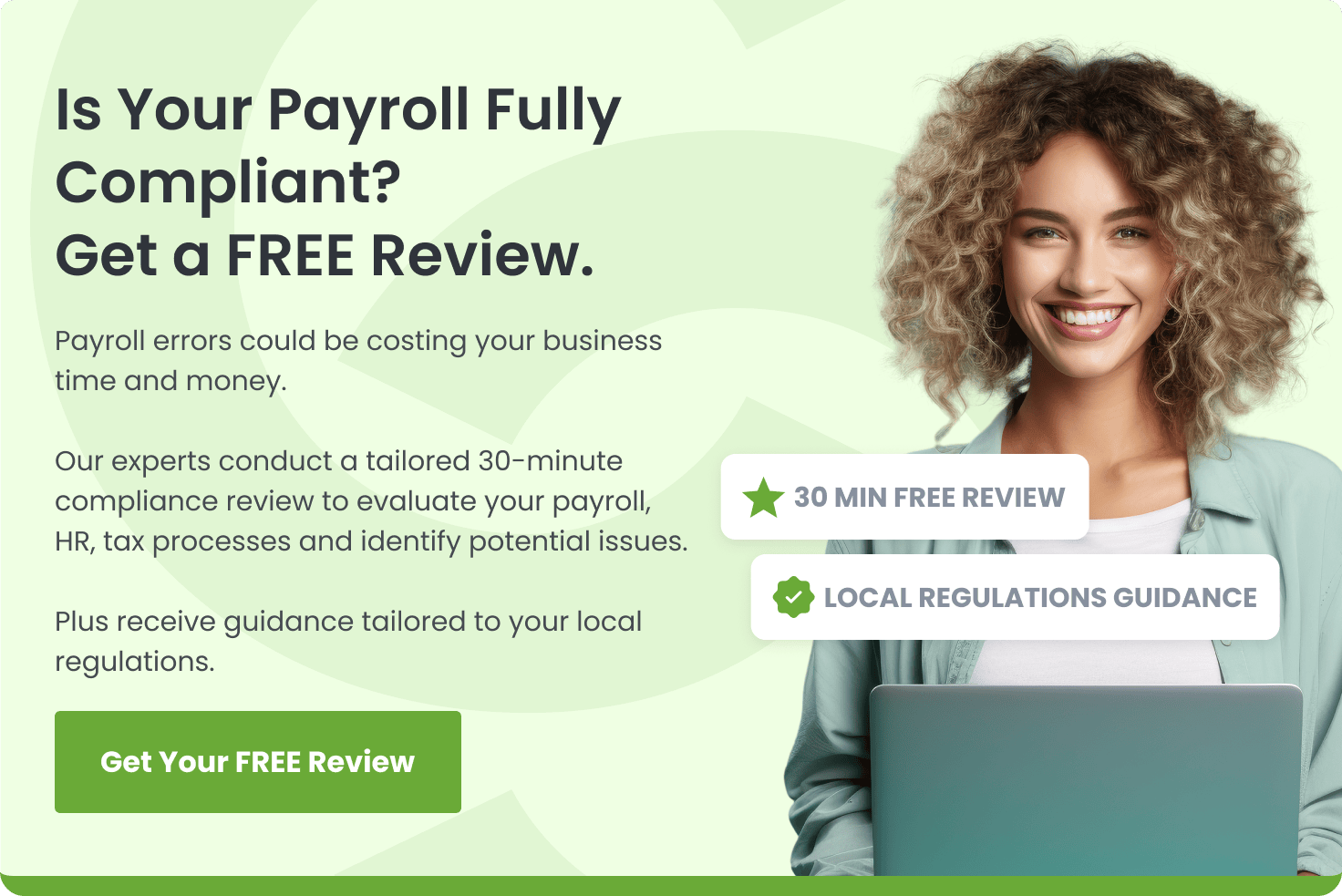7 Tips to Find the Best Payroll and HR for Small Business

As a small business owner, you depend on your people, so paying them accurately and providing quality benefits must be a priority.
Does this sound familiar? Before you know it, your team’s grown, and now you're buried under manual HR and payroll processes, multi-state laws, worker’s compensation red tape, and more. Thankfully, the right payroll partner can support these essential functions and steer you in the right direction.
This article outlines some pros and cons of outsourcing your payroll and HR functions and provides seven tips to help you find your best external partner if that’s the best next step for your small business.
What is the Best Payroll and HR for Small Businesses?
Running payroll and handling human resources may seem simple enough when launching your small business. However, staying on top of changing regulations and ever-more-complex compliance quickly becomes nearly impossible as you grow.
Doing it all in-house requires hiring dedicated payroll and HR specialists that most small business budgets can't afford. And you can't scale effectively with a broken payroll or HR process! The good news is you don't have to figure it out alone or break the bank.
Partnering with an experienced provider like ConnectPay gives you an expert team custom-fitted to your changing business needs and budget. We handle compliance, reporting, taxes, Section 125 benefits administration, labor regulations — taking care of the intricate details — so you can focus on your customers and products rather than paperwork.
And, as you scale up, we’re flexible and can expand our services in step, becoming your outsourced HR department. Explore our HR Resource Center and watch along as our Client Success team walks you through its most popular features, like the HR Hotline and Handbook Builder, to learn more.
Best Payroll and HR for Small Business: 7 Things to Consider
1. Define Your Needs
Take time upfront to understand exactly what you require from a payroll and HR provider. Make lists of your must-have features and functionality to choose the right solution. For example, only consider solutions that cover your non-negotiables to ensure your chosen payroll and HR system meets your needs.
Features to think about might include:
- Worker's compensation
- Specifically, Pay-as-you-go plans to save on insurance costs
- 401K and other retirement plan integration
- Section 125 flexible spending accounts and cafeteria plans
- Easy payroll tax filings
- Time and attendance tracking
- HR compliance resources
- Customized reporting
- Streamlined new-hire onboarding
Outlining these specifics as you vet potential vendors ensures you select a solution fitted for your processes now and flexible enough to adapt as your company grows and your needs evolve. This upfront effort keeps you from picking a partner that ultimately costs more money and time down the road to replace when the services can't grow with you.
2. Research Your Options
After outlining your must-have features in step one above, it’s time to narrow down your options.
Use resources like Trustpilot to read independent software reviews that reveal real pros, cons, and capabilities of the services you are considering—not just vendor claims. Search for candid user feedback (like reviews) from professionals currently using the different systems you’re thinking about.
Another great way to research your options is to sign up for a free product demo or trial - many vendors offer free hands-on test drives of tools and systems. These free trials let you see how the system would work in real time. Investing the extra effort upfront helps you evaluate top contenders through both objective analysis and firsthand software experience.
3. Consider the Costs
Pricing can vary greatly across payroll and HR partners, so cost comparing helps find the most budget-friendly provider for your growing small business. Overspending can negatively impact your bottom line, which directly hurts your company. But remember not to make a decision based on price alone. Choosing the cheapest option and underbuying to save a little money often proves even more expensive in the long term in terms of replacement time and costs.
Either way, not comparing expenses could result in overpaying OR getting an inadequate solution that can’t scale along with your evolving needs. You don’t want to wind up in this pickle.
Our recommendation? Make a simple spreadsheet outlining per-employee monthly fees and one-time setup or migration costs across the best payroll and HR for small businesses that meet your must-have needs. This analysis makes sure you keep your initial and ongoing costs affordable without sacrificing key functions your company needs as part of your workforce framework.
4. Compare Support Options
Issues are inevitable. And, when payroll or compliance problems arise, your provider’s responsiveness can make or break your experience (and the outcome of the problem you’re having!). Slow or inadequate support puts you at risk of losing customers and stalls your business depending on the severity of the issue.
Before choosing a partner, thoroughly vet their support offerings and guaranteed response times. Ask specifically about channels available — are there phone lines, email, chat boxes, or self-service portals? Is in-house assistance around the clock or only during business hours? What level of HR expertise do support staff have?
Resources like our HR Resource Center offer a dedicated HR hotline connecting you live to industry veterans ready to tackle your detailed questions. Between our payroll software and the HRRC, prompt access to payroll and HR assistance ensures you receive knowledgeable, timely support to handle any curveballs with minimal business disruption.
5. Prioritize Data Security
Protect sensitive payroll and employee data by thoroughly evaluating your potential provider's security guarantees. Prioritizing rigorous data safety starts with choosing a partner that locks down vulnerabilities behind the scenes. Security risks can lead to leaked private data, severely impact your team’s privacy, damage your reputation, and let cyber threats infiltrate other vulnerable parts of your business.
The right partner will actively safeguard your data and information by leveraging 256-bit data encryption, routinely auditing for Service Organization Control (SOC) Type 2 compliance, and upholding other robust measures that meet banking-level standards.
Specifically, ask about cloud monitoring, encryption methods, security certifications, and backup protocols like 3-2-1 strategies. A 3-2-1 strategy suggests you have three copies of all data: one copy in production and two backup copies. You should also use two different media or file types, and you should make sure one copy is on the cloud off-site.
You should also inquire about their proactive defences: multi-factor authentication, infrastructure monitoring, and email phishing identification processes can help you catch irregular activity and stop cyber threats before they reach your information.
6. Consider Potential Integrations
You should also aim to integrate your payroll and HR software with other critical business systems, like time and attendance tracking, benefits administration, and employee portals.
Small-business-focused payroll providers like us at ConnectPay typically offer these resources alongside their service. That way we can answer all of your questions when you need us–whether they’re about using the payroll software, your time & attendance solution, or the HR Resource Center.
Assessing each potential provider's integration capabilities helps you maximize productivity by minimizing manual re-entry across platforms as your business scales. Poor or missing integrations waste significant time that you could spend focusing on customers and other growth efforts.
Specifically, ask your potential partners if they integrate with the tech stack you’re already using — or have the flexibility to connect with future additions. And find out if building custom integrations adds extra fees or not.
This might make a tool you can afford right now far more expensive down the road. No matter what, your ideal payroll and HR solutions should seamlessly share data across your tech stack to create an efficient single source of accurate information.
7. Keep it Simple
As a small business, you need payroll and HR solutions that will be manageable for non-specialists on your limited team or clear you as you try to handle multiple leadership hats. Specifically, examine how intuitive or unnecessarily complex each provider's software interface seems during product demos.
Assess the quality of the tools you’re seeking more information about. User-friendly tools like our HR Resource Center are easy to use and straightforward. By using simple but effective resources, you’ll reduce friction points that create more headaches than system benefits
When it comes to software features, it’s quality over quantity–because you likely won’t need all the fancy bells and whistles of a flashy bundle deal. Make a list of the features that you need and do your best to stick to it!
Get the Best Payroll and HR for Small Businesses with ConnectPay
Establishing proper payroll and HR procedures is core to your continued growth and success as a small business owner. But setting up compliant, scalable systems from scratch can feel overwhelming if this is your first time doing it. We’re here to help!
Outsourcing to an experienced payroll and HR provider like our team at ConnectPay means you have experts working for you to ensure your processes are correct. Our HR Resource Center can help you manage critical HR tasks as you manage and scale your business. Our clients love tools like the Employee Handbook Builder and the HR Hotline– want to learn more? You can watch HRRC demos here!
If you're curious about what our team at ConnectPay can do for your growing business, schedule a free Payroll Tax and Compliance Review today. We'll discuss your biggest frustrations and pitfalls and then provide targeted suggestions and solutions. If it's a mutual fit, we can work together to make your payroll and HR run like a machine.








